Identifying New Challenges for Ethnomusicology in a Global Age Report
VerifiedAdded on 2021/02/20
|57
|13097
|98
Report
AI Summary
This report delves into the evolving field of ethnomusicology, focusing on the identification of new challenges presented by globalization. The research begins with an introduction to the core concepts of ethnomusicology, emphasizing its role in studying music within its cultural and social contexts. The literature review explores the existing body of knowledge, highlighting how globalization has introduced new complexities to the field. The methodology section details the research approach, data collection techniques, and analysis methods used. The data analysis and discussion sections present the findings, examining the impact of these challenges on ethnomusicological studies. The report concludes with reflections on the research process, alternative methodologies, and recommendations for future studies. The report aims to provide a comprehensive overview of the current state of ethnomusicology and the challenges it faces in a rapidly changing world, providing valuable insights into music's role in a globalized society.
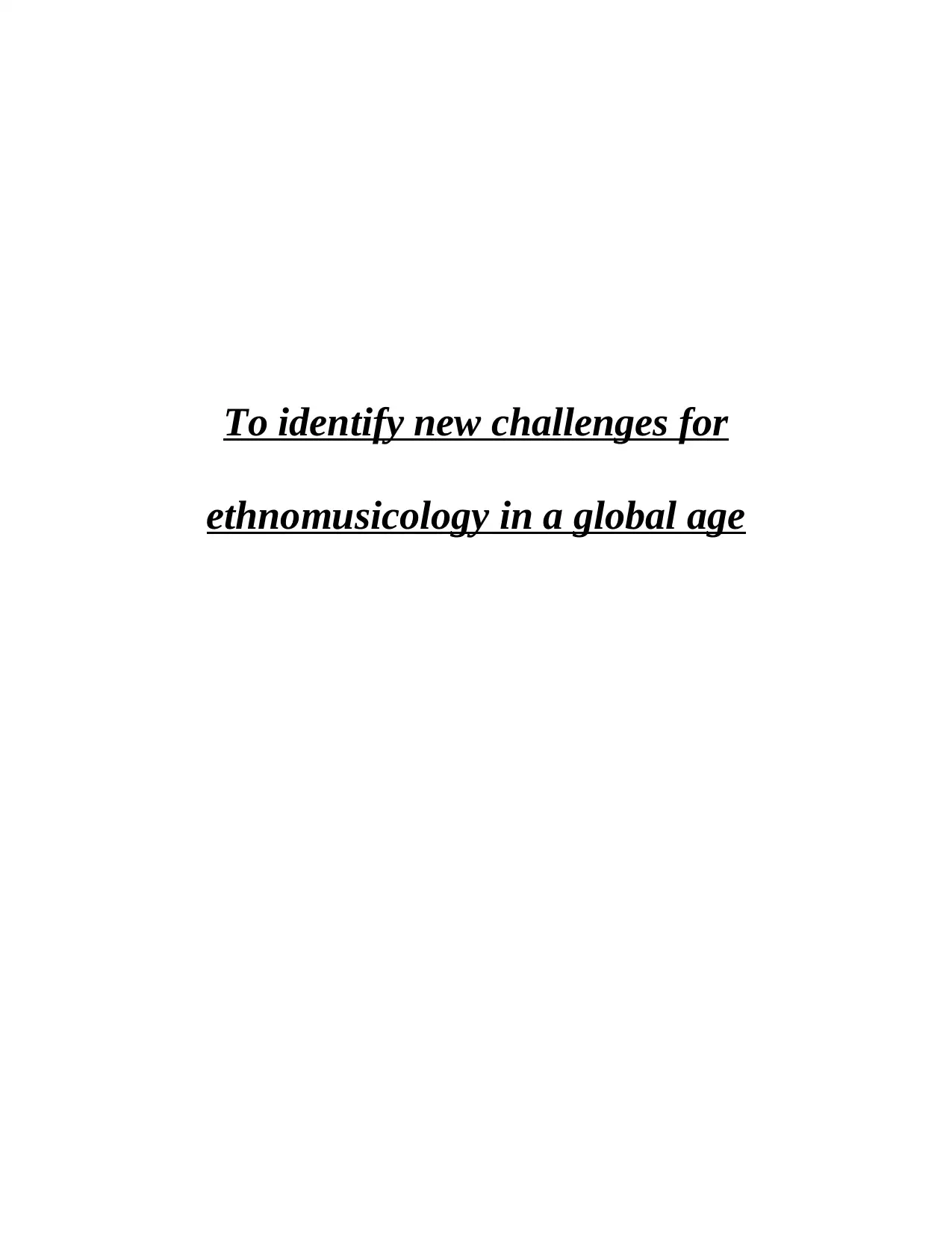
To identify new challenges for
ethnomusicology in a global age
ethnomusicology in a global age
Paraphrase This Document
Need a fresh take? Get an instant paraphrase of this document with our AI Paraphraser
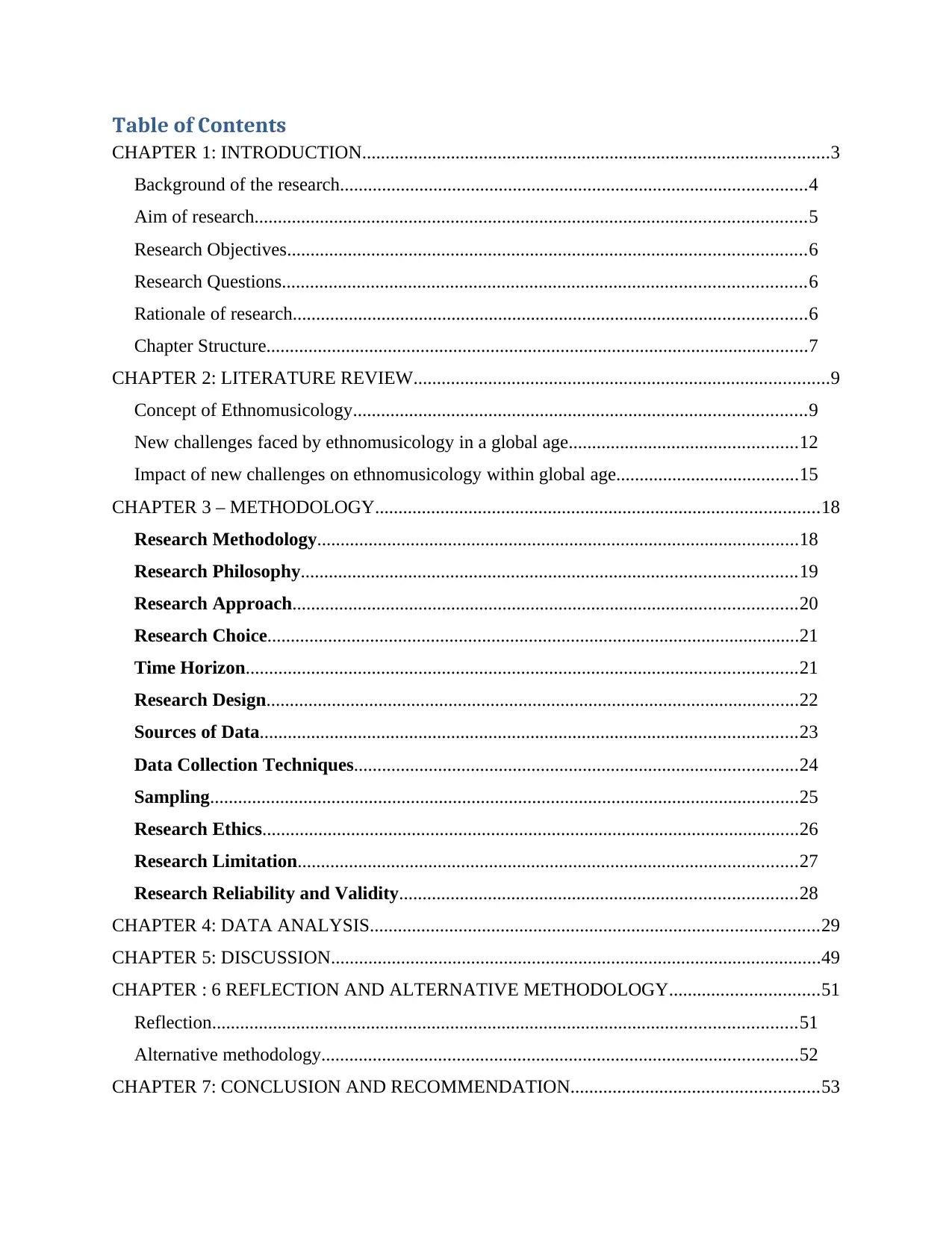
Table of Contents
CHAPTER 1: INTRODUCTION....................................................................................................3
Background of the research....................................................................................................4
Aim of research......................................................................................................................5
Research Objectives...............................................................................................................6
Research Questions................................................................................................................6
Rationale of research..............................................................................................................6
Chapter Structure....................................................................................................................7
CHAPTER 2: LITERATURE REVIEW.........................................................................................9
Concept of Ethnomusicology.................................................................................................9
New challenges faced by ethnomusicology in a global age.................................................12
Impact of new challenges on ethnomusicology within global age.......................................15
CHAPTER 3 – METHODOLOGY...............................................................................................18
Research Methodology.......................................................................................................18
Research Philosophy..........................................................................................................19
Research Approach............................................................................................................20
Research Choice..................................................................................................................21
Time Horizon......................................................................................................................21
Research Design..................................................................................................................22
Sources of Data...................................................................................................................23
Data Collection Techniques...............................................................................................24
Sampling..............................................................................................................................25
Research Ethics...................................................................................................................26
Research Limitation...........................................................................................................27
Research Reliability and Validity.....................................................................................28
CHAPTER 4: DATA ANALYSIS................................................................................................29
CHAPTER 5: DISCUSSION.........................................................................................................49
CHAPTER : 6 REFLECTION AND ALTERNATIVE METHODOLOGY................................51
Reflection.............................................................................................................................51
Alternative methodology......................................................................................................52
CHAPTER 7: CONCLUSION AND RECOMMENDATION.....................................................53
CHAPTER 1: INTRODUCTION....................................................................................................3
Background of the research....................................................................................................4
Aim of research......................................................................................................................5
Research Objectives...............................................................................................................6
Research Questions................................................................................................................6
Rationale of research..............................................................................................................6
Chapter Structure....................................................................................................................7
CHAPTER 2: LITERATURE REVIEW.........................................................................................9
Concept of Ethnomusicology.................................................................................................9
New challenges faced by ethnomusicology in a global age.................................................12
Impact of new challenges on ethnomusicology within global age.......................................15
CHAPTER 3 – METHODOLOGY...............................................................................................18
Research Methodology.......................................................................................................18
Research Philosophy..........................................................................................................19
Research Approach............................................................................................................20
Research Choice..................................................................................................................21
Time Horizon......................................................................................................................21
Research Design..................................................................................................................22
Sources of Data...................................................................................................................23
Data Collection Techniques...............................................................................................24
Sampling..............................................................................................................................25
Research Ethics...................................................................................................................26
Research Limitation...........................................................................................................27
Research Reliability and Validity.....................................................................................28
CHAPTER 4: DATA ANALYSIS................................................................................................29
CHAPTER 5: DISCUSSION.........................................................................................................49
CHAPTER : 6 REFLECTION AND ALTERNATIVE METHODOLOGY................................51
Reflection.............................................................................................................................51
Alternative methodology......................................................................................................52
CHAPTER 7: CONCLUSION AND RECOMMENDATION.....................................................53

CONCLUSION...................................................................................................................53
REFERENCES..............................................................................................................................55
REFERENCES..............................................................................................................................55
⊘ This is a preview!⊘
Do you want full access?
Subscribe today to unlock all pages.

Trusted by 1+ million students worldwide
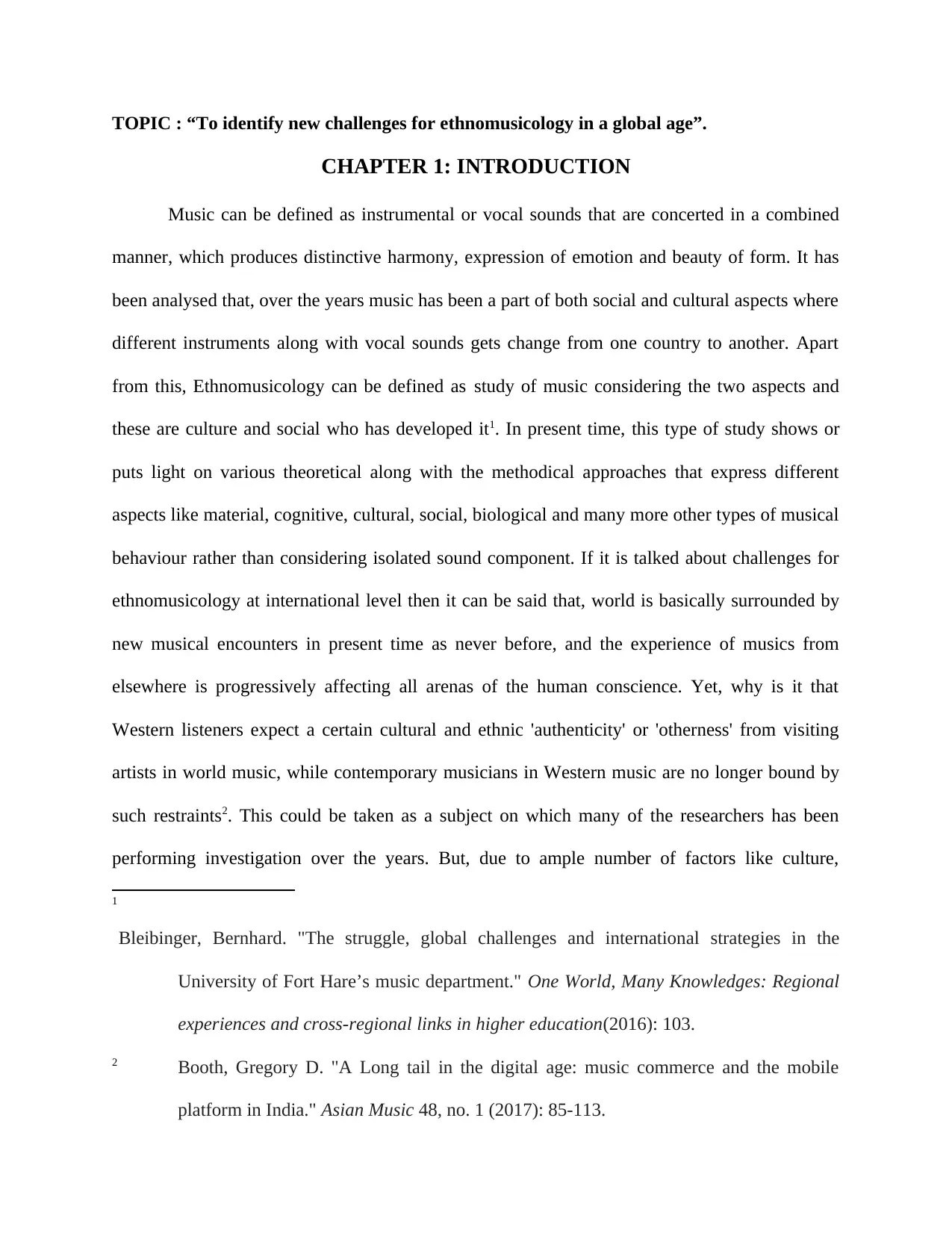
TOPIC : “To identify new challenges for ethnomusicology in a global age”.
CHAPTER 1: INTRODUCTION
Music can be defined as instrumental or vocal sounds that are concerted in a combined
manner, which produces distinctive harmony, expression of emotion and beauty of form. It has
been analysed that, over the years music has been a part of both social and cultural aspects where
different instruments along with vocal sounds gets change from one country to another. Apart
from this, Ethnomusicology can be defined as study of music considering the two aspects and
these are culture and social who has developed it1. In present time, this type of study shows or
puts light on various theoretical along with the methodical approaches that express different
aspects like material, cognitive, cultural, social, biological and many more other types of musical
behaviour rather than considering isolated sound component. If it is talked about challenges for
ethnomusicology at international level then it can be said that, world is basically surrounded by
new musical encounters in present time as never before, and the experience of musics from
elsewhere is progressively affecting all arenas of the human conscience. Yet, why is it that
Western listeners expect a certain cultural and ethnic 'authenticity' or 'otherness' from visiting
artists in world music, while contemporary musicians in Western music are no longer bound by
such restraints2. This could be taken as a subject on which many of the researchers has been
performing investigation over the years. But, due to ample number of factors like culture,
1
Bleibinger, Bernhard. "The struggle, global challenges and international strategies in the
University of Fort Hare’s music department." One World, Many Knowledges: Regional
experiences and cross-regional links in higher education(2016): 103.
2 Booth, Gregory D. "A Long tail in the digital age: music commerce and the mobile
platform in India." Asian Music 48, no. 1 (2017): 85-113.
CHAPTER 1: INTRODUCTION
Music can be defined as instrumental or vocal sounds that are concerted in a combined
manner, which produces distinctive harmony, expression of emotion and beauty of form. It has
been analysed that, over the years music has been a part of both social and cultural aspects where
different instruments along with vocal sounds gets change from one country to another. Apart
from this, Ethnomusicology can be defined as study of music considering the two aspects and
these are culture and social who has developed it1. In present time, this type of study shows or
puts light on various theoretical along with the methodical approaches that express different
aspects like material, cognitive, cultural, social, biological and many more other types of musical
behaviour rather than considering isolated sound component. If it is talked about challenges for
ethnomusicology at international level then it can be said that, world is basically surrounded by
new musical encounters in present time as never before, and the experience of musics from
elsewhere is progressively affecting all arenas of the human conscience. Yet, why is it that
Western listeners expect a certain cultural and ethnic 'authenticity' or 'otherness' from visiting
artists in world music, while contemporary musicians in Western music are no longer bound by
such restraints2. This could be taken as a subject on which many of the researchers has been
performing investigation over the years. But, due to ample number of factors like culture,
1
Bleibinger, Bernhard. "The struggle, global challenges and international strategies in the
University of Fort Hare’s music department." One World, Many Knowledges: Regional
experiences and cross-regional links in higher education(2016): 103.
2 Booth, Gregory D. "A Long tail in the digital age: music commerce and the mobile
platform in India." Asian Music 48, no. 1 (2017): 85-113.
Paraphrase This Document
Need a fresh take? Get an instant paraphrase of this document with our AI Paraphraser
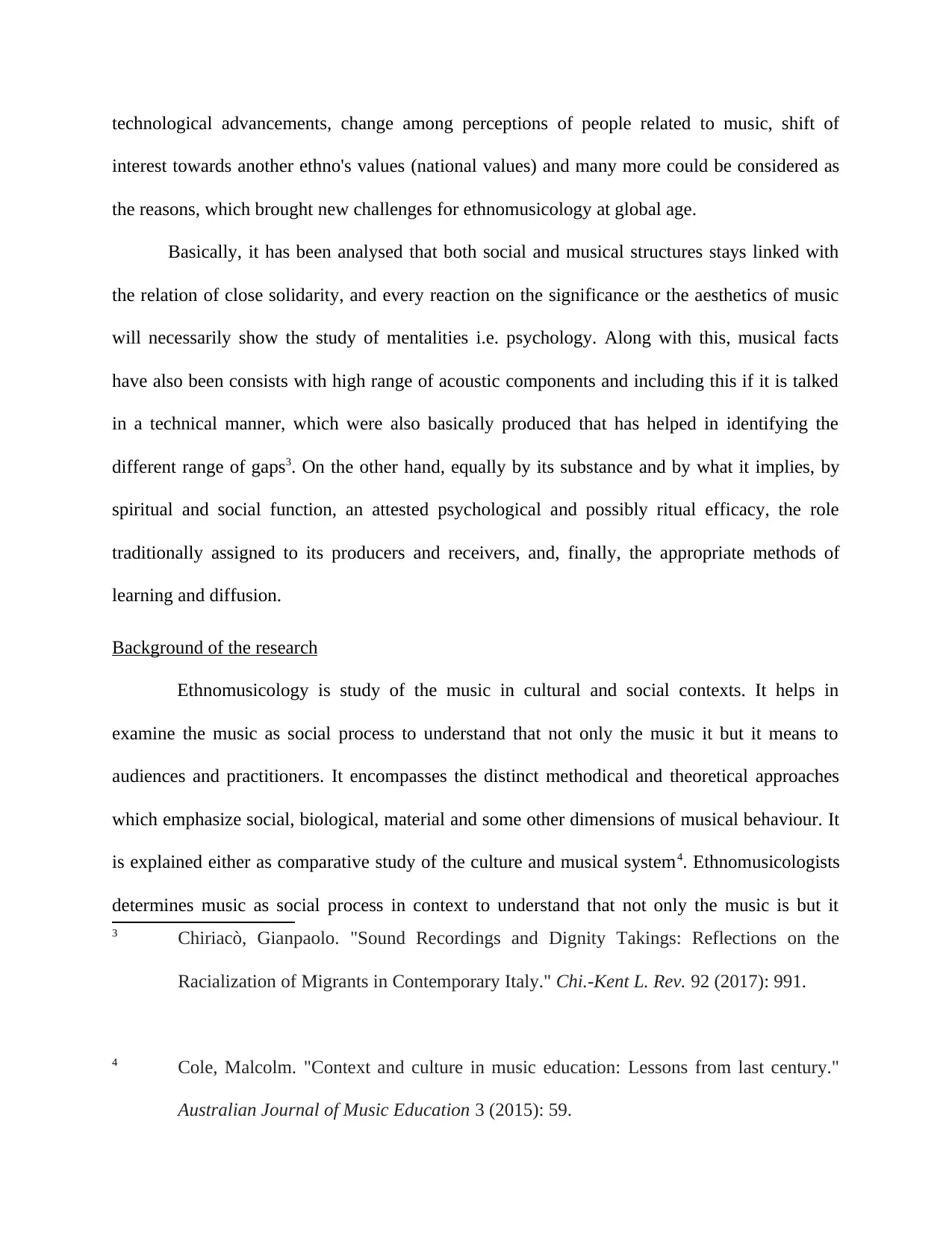
technological advancements, change among perceptions of people related to music, shift of
interest towards another ethno's values (national values) and many more could be considered as
the reasons, which brought new challenges for ethnomusicology at global age.
Basically, it has been analysed that both social and musical structures stays linked with
the relation of close solidarity, and every reaction on the significance or the aesthetics of music
will necessarily show the study of mentalities i.e. psychology. Along with this, musical facts
have also been consists with high range of acoustic components and including this if it is talked
in a technical manner, which were also basically produced that has helped in identifying the
different range of gaps3. On the other hand, equally by its substance and by what it implies, by
spiritual and social function, an attested psychological and possibly ritual efficacy, the role
traditionally assigned to its producers and receivers, and, finally, the appropriate methods of
learning and diffusion.
Background of the research
Ethnomusicology is study of the music in cultural and social contexts. It helps in
examine the music as social process to understand that not only the music it but it means to
audiences and practitioners. It encompasses the distinct methodical and theoretical approaches
which emphasize social, biological, material and some other dimensions of musical behaviour. It
is explained either as comparative study of the culture and musical system4. Ethnomusicologists
determines music as social process in context to understand that not only the music is but it
3 Chiriacò, Gianpaolo. "Sound Recordings and Dignity Takings: Reflections on the
Racialization of Migrants in Contemporary Italy." Chi.-Kent L. Rev. 92 (2017): 991.
4 Cole, Malcolm. "Context and culture in music education: Lessons from last century."
Australian Journal of Music Education 3 (2015): 59.
interest towards another ethno's values (national values) and many more could be considered as
the reasons, which brought new challenges for ethnomusicology at global age.
Basically, it has been analysed that both social and musical structures stays linked with
the relation of close solidarity, and every reaction on the significance or the aesthetics of music
will necessarily show the study of mentalities i.e. psychology. Along with this, musical facts
have also been consists with high range of acoustic components and including this if it is talked
in a technical manner, which were also basically produced that has helped in identifying the
different range of gaps3. On the other hand, equally by its substance and by what it implies, by
spiritual and social function, an attested psychological and possibly ritual efficacy, the role
traditionally assigned to its producers and receivers, and, finally, the appropriate methods of
learning and diffusion.
Background of the research
Ethnomusicology is study of the music in cultural and social contexts. It helps in
examine the music as social process to understand that not only the music it but it means to
audiences and practitioners. It encompasses the distinct methodical and theoretical approaches
which emphasize social, biological, material and some other dimensions of musical behaviour. It
is explained either as comparative study of the culture and musical system4. Ethnomusicologists
determines music as social process in context to understand that not only the music is but it
3 Chiriacò, Gianpaolo. "Sound Recordings and Dignity Takings: Reflections on the
Racialization of Migrants in Contemporary Italy." Chi.-Kent L. Rev. 92 (2017): 991.
4 Cole, Malcolm. "Context and culture in music education: Lessons from last century."
Australian Journal of Music Education 3 (2015): 59.
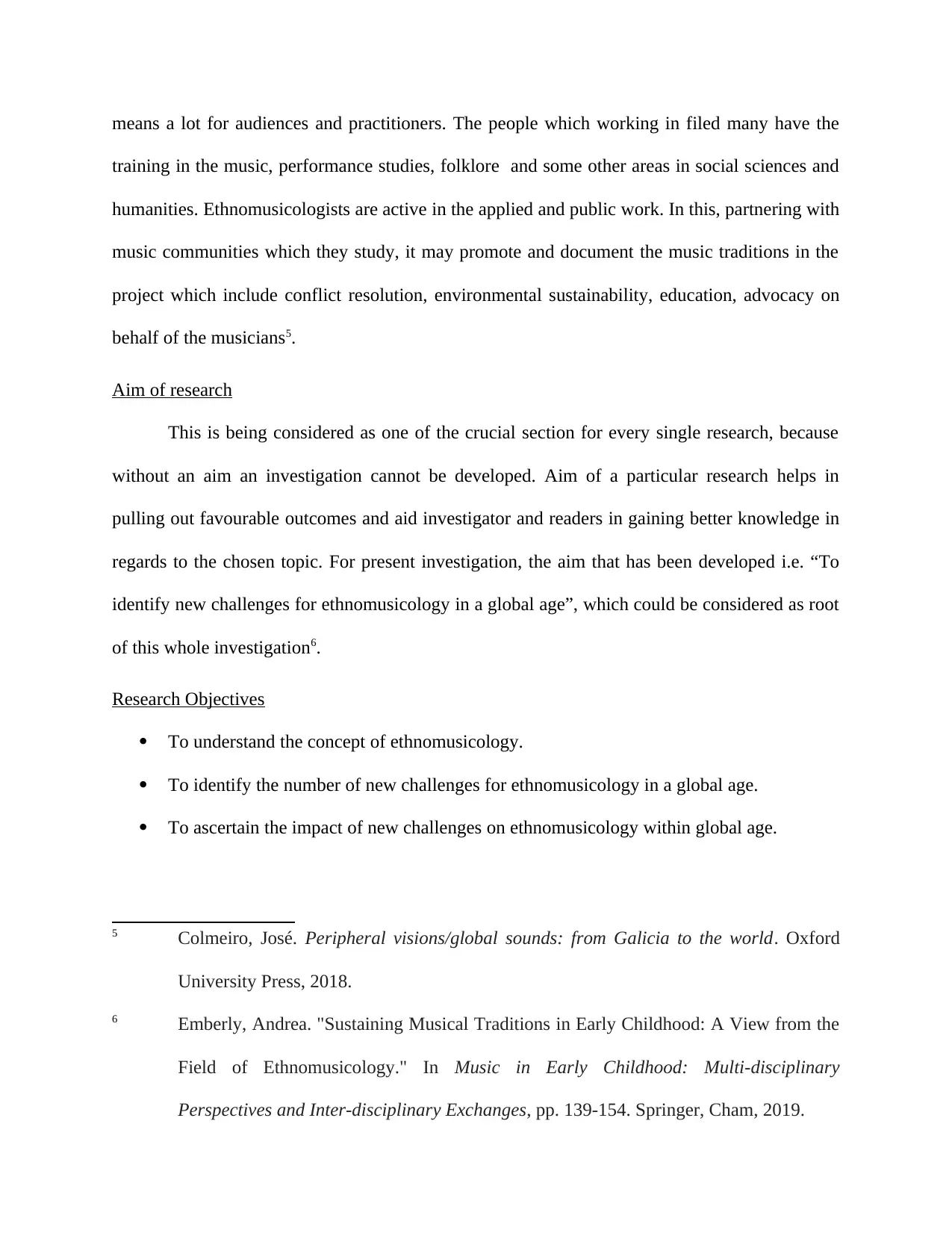
means a lot for audiences and practitioners. The people which working in filed many have the
training in the music, performance studies, folklore and some other areas in social sciences and
humanities. Ethnomusicologists are active in the applied and public work. In this, partnering with
music communities which they study, it may promote and document the music traditions in the
project which include conflict resolution, environmental sustainability, education, advocacy on
behalf of the musicians5.
Aim of research
This is being considered as one of the crucial section for every single research, because
without an aim an investigation cannot be developed. Aim of a particular research helps in
pulling out favourable outcomes and aid investigator and readers in gaining better knowledge in
regards to the chosen topic. For present investigation, the aim that has been developed i.e. “To
identify new challenges for ethnomusicology in a global age”, which could be considered as root
of this whole investigation6.
Research Objectives
To understand the concept of ethnomusicology.
To identify the number of new challenges for ethnomusicology in a global age.
To ascertain the impact of new challenges on ethnomusicology within global age.
5 Colmeiro, José. Peripheral visions/global sounds: from Galicia to the world. Oxford
University Press, 2018.
6 Emberly, Andrea. "Sustaining Musical Traditions in Early Childhood: A View from the
Field of Ethnomusicology." In Music in Early Childhood: Multi-disciplinary
Perspectives and Inter-disciplinary Exchanges, pp. 139-154. Springer, Cham, 2019.
training in the music, performance studies, folklore and some other areas in social sciences and
humanities. Ethnomusicologists are active in the applied and public work. In this, partnering with
music communities which they study, it may promote and document the music traditions in the
project which include conflict resolution, environmental sustainability, education, advocacy on
behalf of the musicians5.
Aim of research
This is being considered as one of the crucial section for every single research, because
without an aim an investigation cannot be developed. Aim of a particular research helps in
pulling out favourable outcomes and aid investigator and readers in gaining better knowledge in
regards to the chosen topic. For present investigation, the aim that has been developed i.e. “To
identify new challenges for ethnomusicology in a global age”, which could be considered as root
of this whole investigation6.
Research Objectives
To understand the concept of ethnomusicology.
To identify the number of new challenges for ethnomusicology in a global age.
To ascertain the impact of new challenges on ethnomusicology within global age.
5 Colmeiro, José. Peripheral visions/global sounds: from Galicia to the world. Oxford
University Press, 2018.
6 Emberly, Andrea. "Sustaining Musical Traditions in Early Childhood: A View from the
Field of Ethnomusicology." In Music in Early Childhood: Multi-disciplinary
Perspectives and Inter-disciplinary Exchanges, pp. 139-154. Springer, Cham, 2019.
⊘ This is a preview!⊘
Do you want full access?
Subscribe today to unlock all pages.

Trusted by 1+ million students worldwide

Research Questions
What is the concept of ethnomusicology ?
What are the number of new challenges for ethnomusicology in a global age ?
How ethnomusicology is affected by the new challenges at global age ?
Rationale of research
This present report is taken in to consideration on The rationale behind conducting this
investigation is to identify new challenges for ethnomusicology in a global age. It helps in
provide the deep understanding about ethnomusicology in detailed manner. The researcher
conduct investigation for their personal interest and professional. It helps in giving the deep
understanding about particular area and helpful in conducting any investigation in significant
manner7. On the other hand, research is helpful in enhancing the knowledge and the skills of a
researcher so that it can able to perform the all research activities in systematic manner.
Chapter Structure
This section provides the systematic information about the chapters which included in
conducting a research project. Through this, researcher can able to get the positive outcomes or
completing research within given period of time8.
7 Giuriati, Giovanni. "New trends in the Use of audiovisual (and audio) technology in
Contemporary Ethnomusicology." Musical Listening in the Age of Technological
Reproduction (2016): 345.
8 Gold, John R., George Revill, and Daniel Grimley. "Music, Maps and the Global
Jukebox: Culture Areas and Alan Lomax’s Cantometrics Projects Revisited." In
Mapping across academia, pp. 287-303. Springer, Dordrecht, 2017.
What is the concept of ethnomusicology ?
What are the number of new challenges for ethnomusicology in a global age ?
How ethnomusicology is affected by the new challenges at global age ?
Rationale of research
This present report is taken in to consideration on The rationale behind conducting this
investigation is to identify new challenges for ethnomusicology in a global age. It helps in
provide the deep understanding about ethnomusicology in detailed manner. The researcher
conduct investigation for their personal interest and professional. It helps in giving the deep
understanding about particular area and helpful in conducting any investigation in significant
manner7. On the other hand, research is helpful in enhancing the knowledge and the skills of a
researcher so that it can able to perform the all research activities in systematic manner.
Chapter Structure
This section provides the systematic information about the chapters which included in
conducting a research project. Through this, researcher can able to get the positive outcomes or
completing research within given period of time8.
7 Giuriati, Giovanni. "New trends in the Use of audiovisual (and audio) technology in
Contemporary Ethnomusicology." Musical Listening in the Age of Technological
Reproduction (2016): 345.
8 Gold, John R., George Revill, and Daniel Grimley. "Music, Maps and the Global
Jukebox: Culture Areas and Alan Lomax’s Cantometrics Projects Revisited." In
Mapping across academia, pp. 287-303. Springer, Dordrecht, 2017.
Paraphrase This Document
Need a fresh take? Get an instant paraphrase of this document with our AI Paraphraser
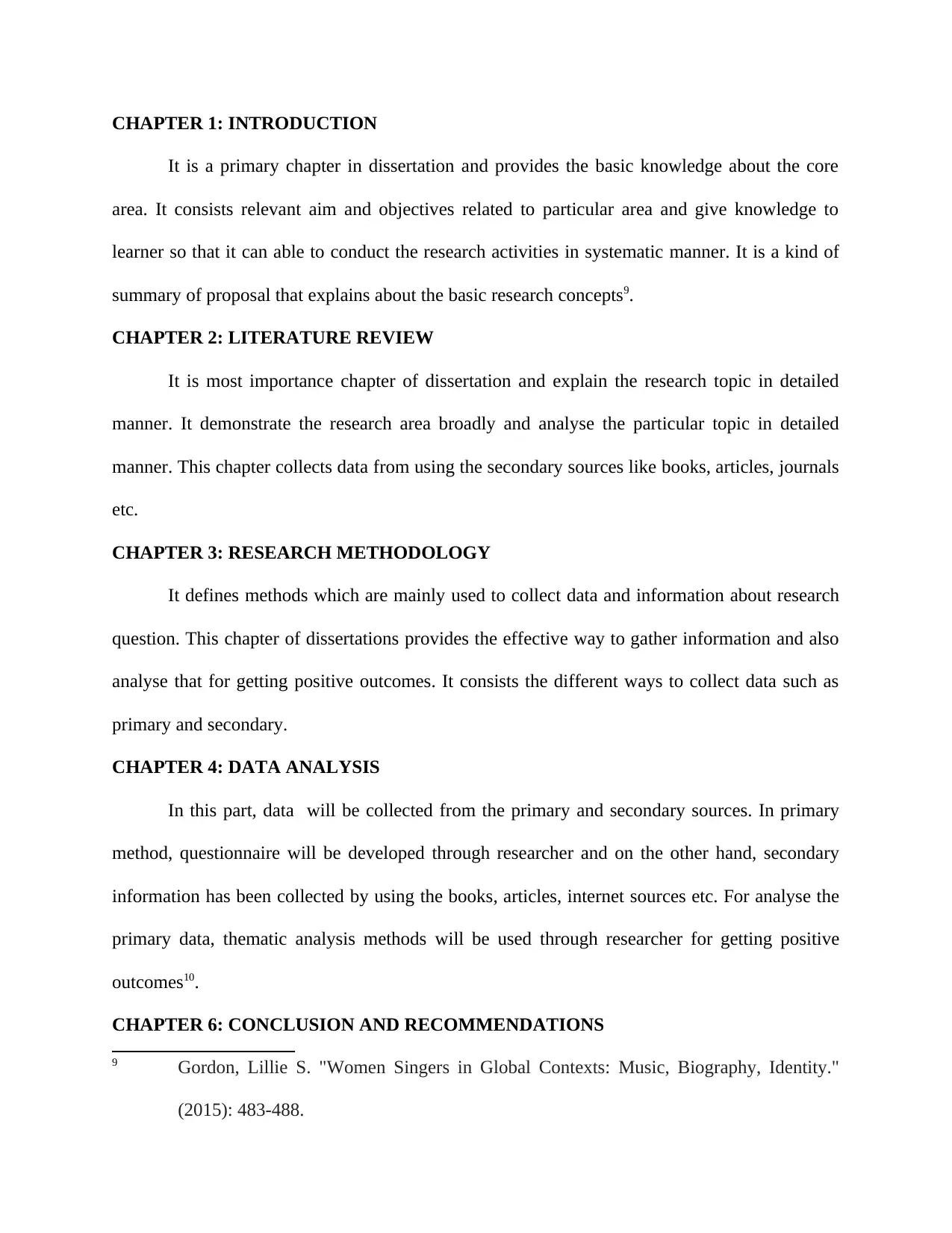
CHAPTER 1: INTRODUCTION
It is a primary chapter in dissertation and provides the basic knowledge about the core
area. It consists relevant aim and objectives related to particular area and give knowledge to
learner so that it can able to conduct the research activities in systematic manner. It is a kind of
summary of proposal that explains about the basic research concepts9.
CHAPTER 2: LITERATURE REVIEW
It is most importance chapter of dissertation and explain the research topic in detailed
manner. It demonstrate the research area broadly and analyse the particular topic in detailed
manner. This chapter collects data from using the secondary sources like books, articles, journals
etc.
CHAPTER 3: RESEARCH METHODOLOGY
It defines methods which are mainly used to collect data and information about research
question. This chapter of dissertations provides the effective way to gather information and also
analyse that for getting positive outcomes. It consists the different ways to collect data such as
primary and secondary.
CHAPTER 4: DATA ANALYSIS
In this part, data will be collected from the primary and secondary sources. In primary
method, questionnaire will be developed through researcher and on the other hand, secondary
information has been collected by using the books, articles, internet sources etc. For analyse the
primary data, thematic analysis methods will be used through researcher for getting positive
outcomes10.
CHAPTER 6: CONCLUSION AND RECOMMENDATIONS
9 Gordon, Lillie S. "Women Singers in Global Contexts: Music, Biography, Identity."
(2015): 483-488.
It is a primary chapter in dissertation and provides the basic knowledge about the core
area. It consists relevant aim and objectives related to particular area and give knowledge to
learner so that it can able to conduct the research activities in systematic manner. It is a kind of
summary of proposal that explains about the basic research concepts9.
CHAPTER 2: LITERATURE REVIEW
It is most importance chapter of dissertation and explain the research topic in detailed
manner. It demonstrate the research area broadly and analyse the particular topic in detailed
manner. This chapter collects data from using the secondary sources like books, articles, journals
etc.
CHAPTER 3: RESEARCH METHODOLOGY
It defines methods which are mainly used to collect data and information about research
question. This chapter of dissertations provides the effective way to gather information and also
analyse that for getting positive outcomes. It consists the different ways to collect data such as
primary and secondary.
CHAPTER 4: DATA ANALYSIS
In this part, data will be collected from the primary and secondary sources. In primary
method, questionnaire will be developed through researcher and on the other hand, secondary
information has been collected by using the books, articles, internet sources etc. For analyse the
primary data, thematic analysis methods will be used through researcher for getting positive
outcomes10.
CHAPTER 6: CONCLUSION AND RECOMMENDATIONS
9 Gordon, Lillie S. "Women Singers in Global Contexts: Music, Biography, Identity."
(2015): 483-488.
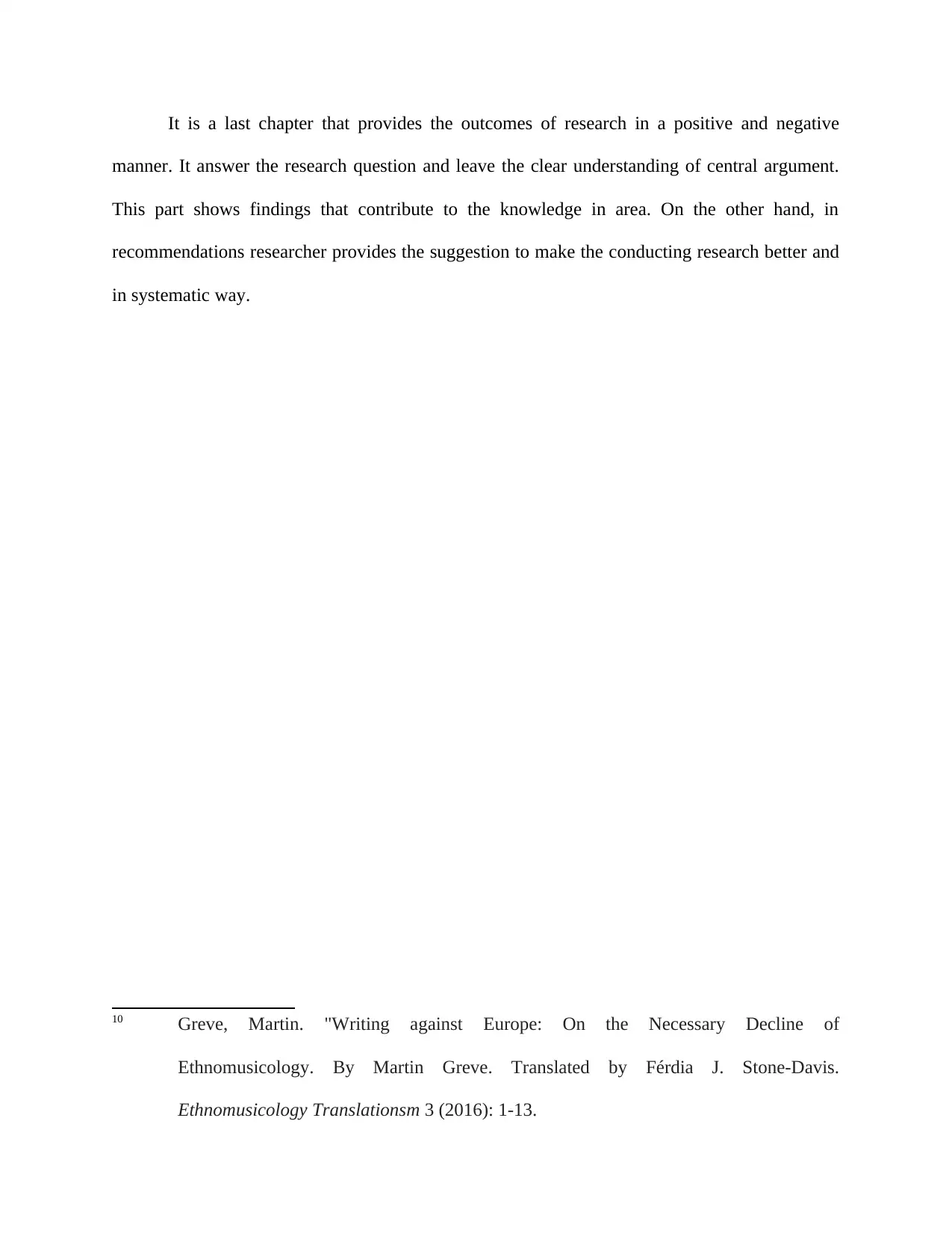
It is a last chapter that provides the outcomes of research in a positive and negative
manner. It answer the research question and leave the clear understanding of central argument.
This part shows findings that contribute to the knowledge in area. On the other hand, in
recommendations researcher provides the suggestion to make the conducting research better and
in systematic way.
10 Greve, Martin. "Writing against Europe: On the Necessary Decline of
Ethnomusicology. By Martin Greve. Translated by Férdia J. Stone-Davis.
Ethnomusicology Translationsm 3 (2016): 1-13.
manner. It answer the research question and leave the clear understanding of central argument.
This part shows findings that contribute to the knowledge in area. On the other hand, in
recommendations researcher provides the suggestion to make the conducting research better and
in systematic way.
10 Greve, Martin. "Writing against Europe: On the Necessary Decline of
Ethnomusicology. By Martin Greve. Translated by Férdia J. Stone-Davis.
Ethnomusicology Translationsm 3 (2016): 1-13.
⊘ This is a preview!⊘
Do you want full access?
Subscribe today to unlock all pages.

Trusted by 1+ million students worldwide
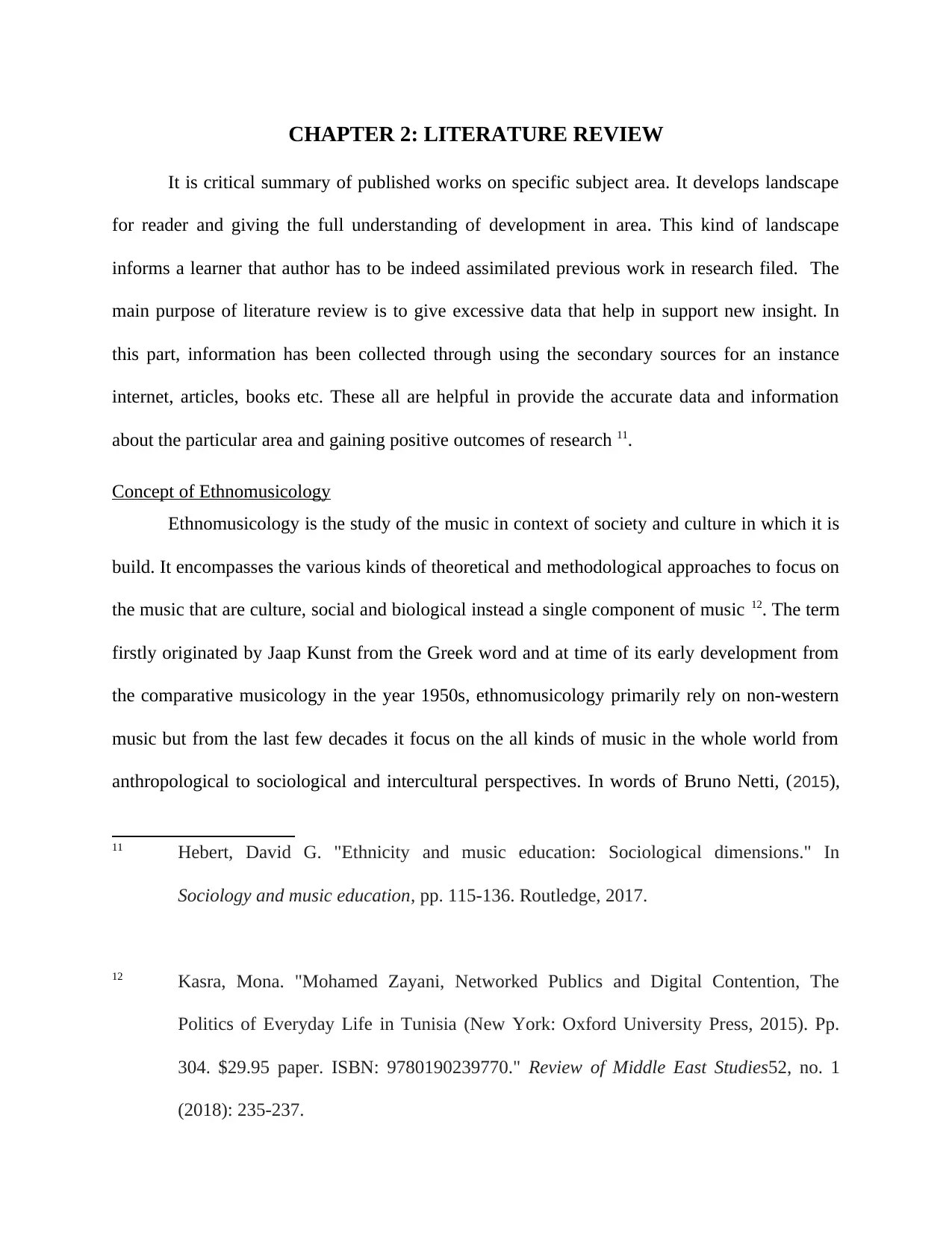
CHAPTER 2: LITERATURE REVIEW
It is critical summary of published works on specific subject area. It develops landscape
for reader and giving the full understanding of development in area. This kind of landscape
informs a learner that author has to be indeed assimilated previous work in research filed. The
main purpose of literature review is to give excessive data that help in support new insight. In
this part, information has been collected through using the secondary sources for an instance
internet, articles, books etc. These all are helpful in provide the accurate data and information
about the particular area and gaining positive outcomes of research 11.
Concept of Ethnomusicology
Ethnomusicology is the study of the music in context of society and culture in which it is
build. It encompasses the various kinds of theoretical and methodological approaches to focus on
the music that are culture, social and biological instead a single component of music 12. The term
firstly originated by Jaap Kunst from the Greek word and at time of its early development from
the comparative musicology in the year 1950s, ethnomusicology primarily rely on non-western
music but from the last few decades it focus on the all kinds of music in the whole world from
anthropological to sociological and intercultural perspectives. In words of Bruno Netti, (2015),
11 Hebert, David G. "Ethnicity and music education: Sociological dimensions." In
Sociology and music education, pp. 115-136. Routledge, 2017.
12 Kasra, Mona. "Mohamed Zayani, Networked Publics and Digital Contention, The
Politics of Everyday Life in Tunisia (New York: Oxford University Press, 2015). Pp.
304. $29.95 paper. ISBN: 9780190239770." Review of Middle East Studies52, no. 1
(2018): 235-237.
It is critical summary of published works on specific subject area. It develops landscape
for reader and giving the full understanding of development in area. This kind of landscape
informs a learner that author has to be indeed assimilated previous work in research filed. The
main purpose of literature review is to give excessive data that help in support new insight. In
this part, information has been collected through using the secondary sources for an instance
internet, articles, books etc. These all are helpful in provide the accurate data and information
about the particular area and gaining positive outcomes of research 11.
Concept of Ethnomusicology
Ethnomusicology is the study of the music in context of society and culture in which it is
build. It encompasses the various kinds of theoretical and methodological approaches to focus on
the music that are culture, social and biological instead a single component of music 12. The term
firstly originated by Jaap Kunst from the Greek word and at time of its early development from
the comparative musicology in the year 1950s, ethnomusicology primarily rely on non-western
music but from the last few decades it focus on the all kinds of music in the whole world from
anthropological to sociological and intercultural perspectives. In words of Bruno Netti, (2015),
11 Hebert, David G. "Ethnicity and music education: Sociological dimensions." In
Sociology and music education, pp. 115-136. Routledge, 2017.
12 Kasra, Mona. "Mohamed Zayani, Networked Publics and Digital Contention, The
Politics of Everyday Life in Tunisia (New York: Oxford University Press, 2015). Pp.
304. $29.95 paper. ISBN: 9780190239770." Review of Middle East Studies52, no. 1
(2018): 235-237.
Paraphrase This Document
Need a fresh take? Get an instant paraphrase of this document with our AI Paraphraser
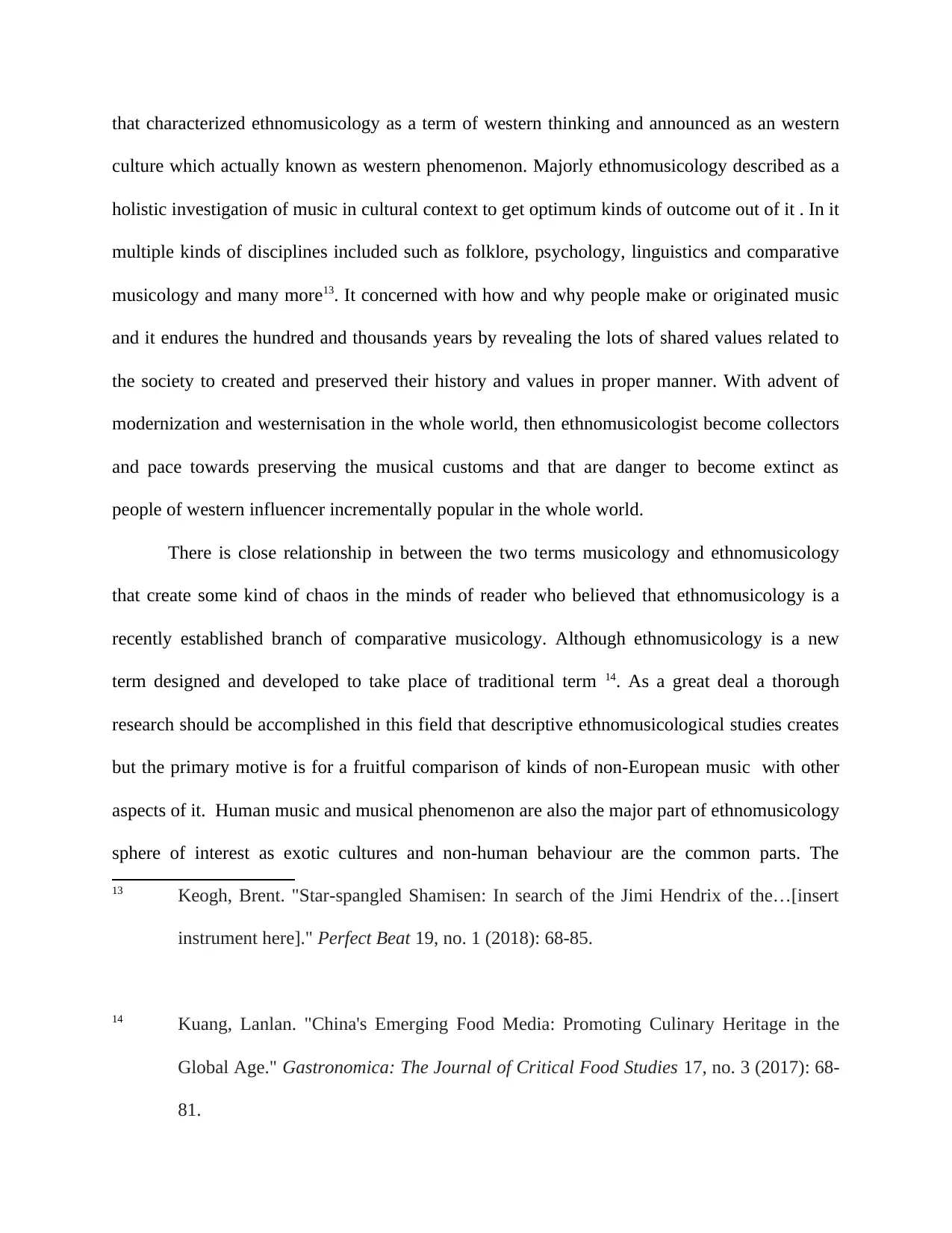
that characterized ethnomusicology as a term of western thinking and announced as an western
culture which actually known as western phenomenon. Majorly ethnomusicology described as a
holistic investigation of music in cultural context to get optimum kinds of outcome out of it . In it
multiple kinds of disciplines included such as folklore, psychology, linguistics and comparative
musicology and many more13. It concerned with how and why people make or originated music
and it endures the hundred and thousands years by revealing the lots of shared values related to
the society to created and preserved their history and values in proper manner. With advent of
modernization and westernisation in the whole world, then ethnomusicologist become collectors
and pace towards preserving the musical customs and that are danger to become extinct as
people of western influencer incrementally popular in the whole world.
There is close relationship in between the two terms musicology and ethnomusicology
that create some kind of chaos in the minds of reader who believed that ethnomusicology is a
recently established branch of comparative musicology. Although ethnomusicology is a new
term designed and developed to take place of traditional term 14. As a great deal a thorough
research should be accomplished in this field that descriptive ethnomusicological studies creates
but the primary motive is for a fruitful comparison of kinds of non-European music with other
aspects of it. Human music and musical phenomenon are also the major part of ethnomusicology
sphere of interest as exotic cultures and non-human behaviour are the common parts. The
13 Keogh, Brent. "Star-spangled Shamisen: In search of the Jimi Hendrix of the…[insert
instrument here]." Perfect Beat 19, no. 1 (2018): 68-85.
14 Kuang, Lanlan. "China's Emerging Food Media: Promoting Culinary Heritage in the
Global Age." Gastronomica: The Journal of Critical Food Studies 17, no. 3 (2017): 68-
81.
culture which actually known as western phenomenon. Majorly ethnomusicology described as a
holistic investigation of music in cultural context to get optimum kinds of outcome out of it . In it
multiple kinds of disciplines included such as folklore, psychology, linguistics and comparative
musicology and many more13. It concerned with how and why people make or originated music
and it endures the hundred and thousands years by revealing the lots of shared values related to
the society to created and preserved their history and values in proper manner. With advent of
modernization and westernisation in the whole world, then ethnomusicologist become collectors
and pace towards preserving the musical customs and that are danger to become extinct as
people of western influencer incrementally popular in the whole world.
There is close relationship in between the two terms musicology and ethnomusicology
that create some kind of chaos in the minds of reader who believed that ethnomusicology is a
recently established branch of comparative musicology. Although ethnomusicology is a new
term designed and developed to take place of traditional term 14. As a great deal a thorough
research should be accomplished in this field that descriptive ethnomusicological studies creates
but the primary motive is for a fruitful comparison of kinds of non-European music with other
aspects of it. Human music and musical phenomenon are also the major part of ethnomusicology
sphere of interest as exotic cultures and non-human behaviour are the common parts. The
13 Keogh, Brent. "Star-spangled Shamisen: In search of the Jimi Hendrix of the…[insert
instrument here]." Perfect Beat 19, no. 1 (2018): 68-85.
14 Kuang, Lanlan. "China's Emerging Food Media: Promoting Culinary Heritage in the
Global Age." Gastronomica: The Journal of Critical Food Studies 17, no. 3 (2017): 68-
81.
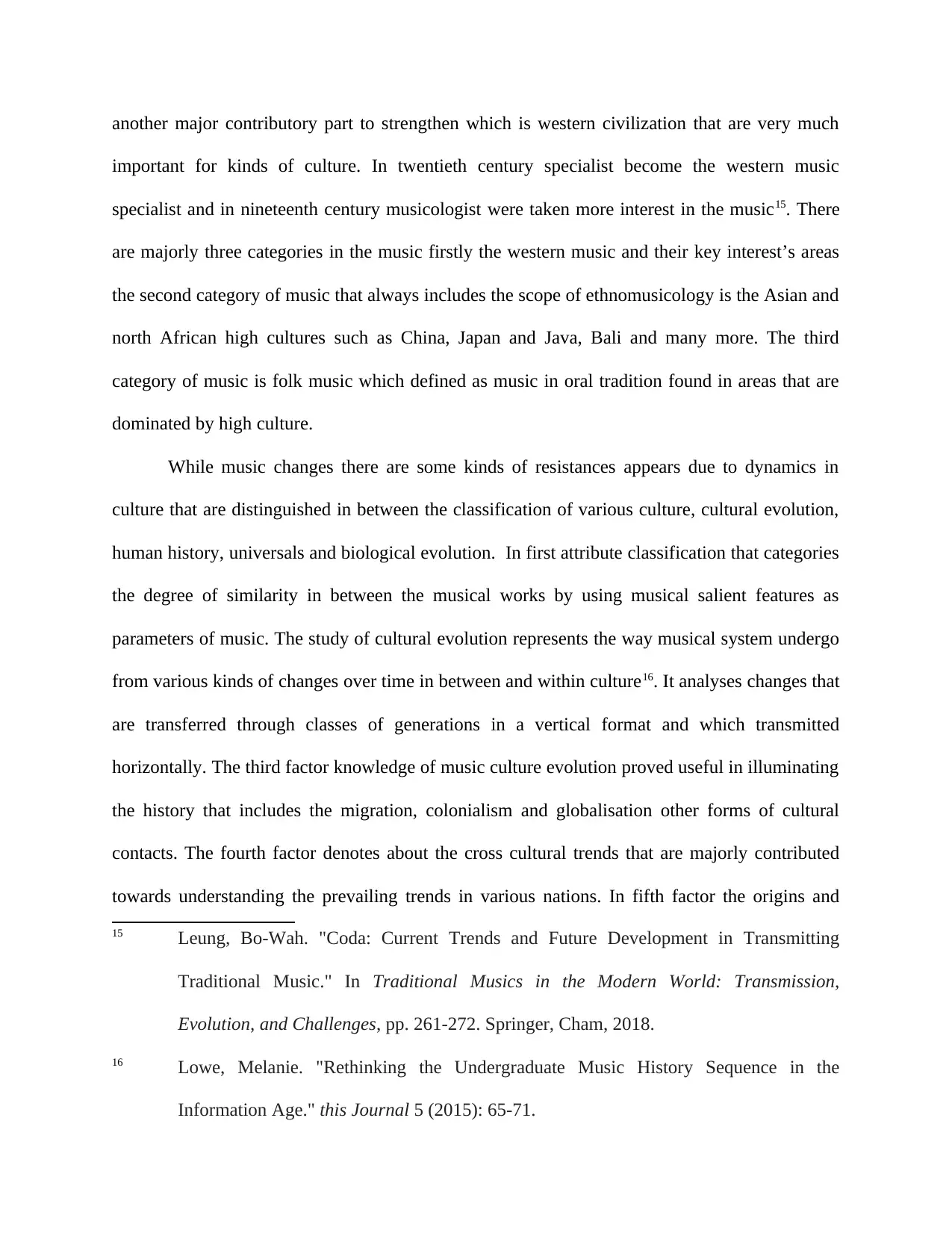
another major contributory part to strengthen which is western civilization that are very much
important for kinds of culture. In twentieth century specialist become the western music
specialist and in nineteenth century musicologist were taken more interest in the music15. There
are majorly three categories in the music firstly the western music and their key interest’s areas
the second category of music that always includes the scope of ethnomusicology is the Asian and
north African high cultures such as China, Japan and Java, Bali and many more. The third
category of music is folk music which defined as music in oral tradition found in areas that are
dominated by high culture.
While music changes there are some kinds of resistances appears due to dynamics in
culture that are distinguished in between the classification of various culture, cultural evolution,
human history, universals and biological evolution. In first attribute classification that categories
the degree of similarity in between the musical works by using musical salient features as
parameters of music. The study of cultural evolution represents the way musical system undergo
from various kinds of changes over time in between and within culture16. It analyses changes that
are transferred through classes of generations in a vertical format and which transmitted
horizontally. The third factor knowledge of music culture evolution proved useful in illuminating
the history that includes the migration, colonialism and globalisation other forms of cultural
contacts. The fourth factor denotes about the cross cultural trends that are majorly contributed
towards understanding the prevailing trends in various nations. In fifth factor the origins and
15 Leung, Bo-Wah. "Coda: Current Trends and Future Development in Transmitting
Traditional Music." In Traditional Musics in the Modern World: Transmission,
Evolution, and Challenges, pp. 261-272. Springer, Cham, 2018.
16 Lowe, Melanie. "Rethinking the Undergraduate Music History Sequence in the
Information Age." this Journal 5 (2015): 65-71.
important for kinds of culture. In twentieth century specialist become the western music
specialist and in nineteenth century musicologist were taken more interest in the music15. There
are majorly three categories in the music firstly the western music and their key interest’s areas
the second category of music that always includes the scope of ethnomusicology is the Asian and
north African high cultures such as China, Japan and Java, Bali and many more. The third
category of music is folk music which defined as music in oral tradition found in areas that are
dominated by high culture.
While music changes there are some kinds of resistances appears due to dynamics in
culture that are distinguished in between the classification of various culture, cultural evolution,
human history, universals and biological evolution. In first attribute classification that categories
the degree of similarity in between the musical works by using musical salient features as
parameters of music. The study of cultural evolution represents the way musical system undergo
from various kinds of changes over time in between and within culture16. It analyses changes that
are transferred through classes of generations in a vertical format and which transmitted
horizontally. The third factor knowledge of music culture evolution proved useful in illuminating
the history that includes the migration, colonialism and globalisation other forms of cultural
contacts. The fourth factor denotes about the cross cultural trends that are majorly contributed
towards understanding the prevailing trends in various nations. In fifth factor the origins and
15 Leung, Bo-Wah. "Coda: Current Trends and Future Development in Transmitting
Traditional Music." In Traditional Musics in the Modern World: Transmission,
Evolution, and Challenges, pp. 261-272. Springer, Cham, 2018.
16 Lowe, Melanie. "Rethinking the Undergraduate Music History Sequence in the
Information Age." this Journal 5 (2015): 65-71.
⊘ This is a preview!⊘
Do you want full access?
Subscribe today to unlock all pages.

Trusted by 1+ million students worldwide
1 out of 57